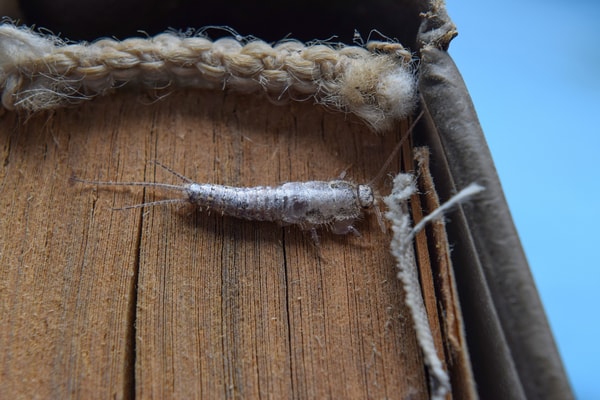Have you ever pulled a favorite book off the shelf only to have a few silverfish dart out? These creepy insects are enough to give most people the heebie-jeebies.

But are silverfish harmful to humans? Is your reaction to the insect something instinctual that’s telling you to keep away? And can they damage your home? Learn more about silverfish and what you can do about them.
What Are Silverfish?
Silverfish are thought to be one of the oldest insects in the world. Many think they were around 100 million years before dinosaurs roamed the earth, meaning the bugs have survived for about 400 million years.
These ancient insects are typically shiny gray or silver and can be anywhere from one-half inch to one inch long. Unlike most other insects, silverfish shed their skins throughout their adult lives. Throughout the millions of years silverfish have crept around the planet, they never evolved to have wings.
Silverfish are also most active at night, which is why they usually freak you out when you’re reaching for that bedtime book or headed to the bathroom to brush your teeth.
Are Silverfish Harmful to Humans?
Because of their appearance, people may assume that a silverfish is harmful. Here’s the good news: Silverfish are not known to bite and there’s no scientific evidence to suggest silverfish are poisonous. Additionally, they’re not known to carry any pathogens that cause disease.
That being said, they can trigger allergic reactions in some people. As you now know, silverfish shed their skins throughout adulthood in a process called “molting.” When they do this, they leave behind scales. Some people may be allergic to the dust created by the dropped scales.
Now for the bad news: Silverfish aren’t harmful to people, but they can damage your belongings. These insects prefer a diet filled with sugars and carbohydrates, so they’ll chow down on everything from cereals and books to wallpaper, insulation and clothing. They’ll also enjoy tissue, newspaper and cardboard. They’ll even eat human hair that’s fallen to the ground.
While you may not be too upset if an old stack of newspapers slated for the recycling center is eaten, you probably don’t want to find holes in clothing or — worse yet — open a box of family photo albums only to have a bunch of tiny prehistoric monsters stream out and find your pictures ruined.
How to Help Prevent Silverfish
Silverfish are very common insects to have in the home. Unfortunately, getting rid of silverfish is a tough task. Their flat bodies and high speed make them adept hiders. And the fact that silverfish are nocturnal doesn’t make it any easier to spot them.
You don’t have to let silverfish damage your belongings. Here are several steps you can take to help make your home less attractive to silverfish:
- Limit their food sources by keeping dry goods (think cereals, grains, pastas and beans) and pet foods in airtight containers.
- Vacuum carpets, flooring and upholstery regularly to help remove fallen food crumbs.
- Use dehumidifiers in damp areas (including basements) to help remove the moisture that silverfish tend to be attracted to.
- Have dirt floors in crawl spaces or unfinished basements properly lined with plastic sheeting to help control moisture in the structure.
- Have ridge vents properly installed in roofs to help let humidity escape.
- Keep gutters clean and help ensure water drains away from your home.
- Make sure the outside of your house is caulked and well painted.
- Properly seal any open areas, such as seams between walls and ceilings and cracks under and behind baseboards, windows and trim.
What Helps Get Rid of Silverfish?
What if you already have a silverfish infestation or even a minor problem? What helps remove silverfish once and for all?
Silverfish can be tough to completely control. This is especially true in homes that have wooden shingles on the roof. Wood shingles are prone to mold, which silverfish tend to eat, and also hard to treat because it’s challenging to reach all the areas a flat-bodied insect can shelter in.
Because it is so trying to combat a silverfish problem, it’s best to consult a trained pest control technician. DIY methods probably won’t get you far with a true silverfish infestation. Additionally, a trained professional will be better able to help you identify and treat the areas where silverfish may reside.
Don’t let these creepy crawlers take over your house and damage your belongings. Contact Terminix® for help in making these prehistoric creatures history in your home.



